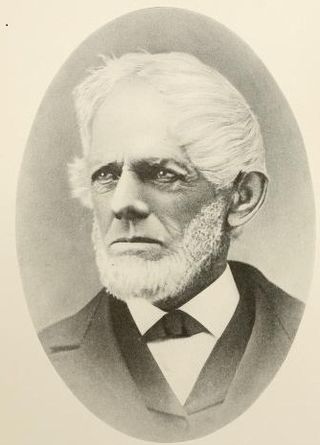
Fruit tree propagation is usually carried out vegetatively (non-sexually) by grafting or budding a desired variety onto a suitable rootstock.

Red Delicious is a type of apple with a red exterior and sweet taste that was first recognized in Madison County, Iowa, in 1872. Today, the name Red Delicious comprises more than 50 cultivars. It was the most produced cultivar in the United States from 1968 to 2018, when it was surpassed by Gala.

Pomology is a branch of botany that studies fruits and their cultivation. Someone who researches and practices the science of pomology is called a pomologist. The term fruticulture is also used to describe the agricultural practice of growing fruits in orchards.

The Baldwin apple is a bright red winter apple, very good in quality, and easily shipped. It was for many years the most popular apple in New England, New York, and for export from the United States of America. It has also been known as 'Calville Butter', 'Felch', 'Late Baldwin', 'Pecker', 'Red Baldwin's Pippin', 'Steele's Red Winter', and 'Woodpecker'.
A rootstock is part of a plant, often an underground part, from which new above-ground growth can be produced. It could also be described as a stem with a well developed root system, to which a bud from another plant is grafted. It can refer to a rhizome or underground stem. In grafting, it refers to a plant, sometimes just a stump, which already has an established, healthy root system, onto which a cutting or a bud from another plant is grafted. In some cases, such as vines of grapes and other berries, cuttings may be used for rootstocks, the roots being established in nursery conditions before planting them out. The plant part grafted onto the rootstock is usually called the scion. The scion is the plant that has the properties that propagator desires above ground, including the photosynthetic activity and the fruit or decorative properties. The rootstock is selected for its interaction with the soil, providing the roots and the stem to support the new plant, obtaining the necessary soil water and minerals, and resisting the relevant pests and diseases. After a few weeks, the tissues of the two parts will have grown together, eventually forming a single plant. After some years, it may be difficult to detect the site of the graft although the product always contains the components of two genetically different plants.

The 'Roxbury Russet' is an apple cultivar, believed to be the oldest apple cultivar bred in the United States, having first been discovered and named in the mid-17th century in the former Town of Roxbury, part of the Massachusetts Bay Colony southwest of Boston. It is known by several other names including 'Boston Russet', 'Putnam Russet', and 'Sylvan Russet'.

The Ben Davis, originally trademarked by the Stark Brothers Nursery as the "Black Ben Davis", is an apple cultivar. Typical size: width 74-80 mm, height 63-75 mm, stalk 19-23 mm.

Charles Downing, was an American pomologist, horticulturist, and author.

Ulysses Prentiss Hedrick (1870–1951) was an American botanist and horticulturist.

The 'York Imperial', or 'York', is a cultivar of apple from which a number of other valuable strains and cultivars have arisen, including four sport varieties: Commander York, Ramey York, Red Yorking, and Yorking.

The Wealthy is an American apple cultivar, and was the earliest to thrive in the Minnesota climate. Horticulturalist Peter Gideon first grew it in 1868, after years of trial and error with various apple varieties.

Reinette du Canada or Canadian Reinette is, despite its name, an old French cultivar of domesticated apple. It is a reinette type of golden apple, with much russeting, which keeps shape in cooking and is mainly used for that purpose especially in apple strudel.
The Lawton blackberry originated in the village of New Rochelle in New York, and was the first widely cultivated variety of blackberry in the United States. It was either an accidental seedling from a wild variety of blackberry, or possibly a sort accidentally brought to this country by the French Huguenots who settled New Rochelle in 1688. The fruit-bearing bush is from the genus Rubus, in the rose family, and bears large berries that grow to about an inch long.

The Tolman Sweet is a cultivar of apple with a butter yellow color, with faint russet dots and a "suture line" along one side of the fruit from top to bottom.

Emmett Stull Goff was a pioneering horticulturist, inventor, writer and educator best known for his early promotion of the cherry growing industry in Door County, Wisconsin.

Szczepan Aleksander Pieniążek (1913–2008) was a Polish pomologist, professor of the Warsaw University of Life Sciences, and a vice-president of the Polish Academy of Sciences. He was a pioneer in Polish horticulture, which was in need of reform after World War II. Having studied in the United States, Pieniążek brought to Poland innovative solutions to various fruit-growing problems. In his scientific research, he generally focused on pomology, plant physiology, and conservation of orchards. He published over one hundred publications, including an academic handbook "Horticulture".

Albert Franklin Yeager was an American horticulturalist. From his work developing hardy vegetables and fruits at the North Dakota Agricultural College (NDAC) and the North Dakota Agricultural Experiment Station (NDAES), he was known as the "plant wizard of the north" and the "Luther Burbank of North Dakota."


 The Wagener (also called Wagener Price and Wagoner [1] ) is a cultivar of the domesticated apple. It was first farmed in 1791 in New York, and is the parent of the Idared and, possibly, the Northern Spy. Despite the early popularity of the Wagener, it is no longer widely grown.
The Wagener (also called Wagener Price and Wagoner [1] ) is a cultivar of the domesticated apple. It was first farmed in 1791 in New York, and is the parent of the Idared and, possibly, the Northern Spy. Despite the early popularity of the Wagener, it is no longer widely grown.













